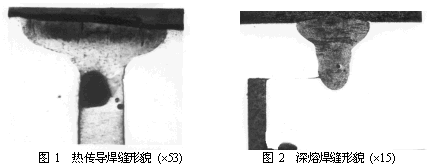Laser welding has two methods: heat conduction and deep fusion welding. When welding, heat conduction welding or deep welding is controlled by laser power density. If the laser power density is greater than the critical power density required by the metal material, deep fusion welding occurs when welding. The absorption rate of the laser is very high, usually 70%~90%, and the obtained weld has a large aspect ratio; if the laser power density is less than the critical power density of the material, heat conduction welding occurs when welding, and the material is laser The absorption rate is very low, usually 10%, and the weld has a small aspect ratio. Oxidation, pores and cracks are the three main problems in the welding of bismuth. Among them, the crack problem is the most difficult to overcome, and controlling the weld profile and reducing the melting of bismuth is one of the effective ways to reduce the sensitivity of cracks. The critical power density and its influencing factors, in the laser welding of bismuth, can select reasonable welding process parameters according to the needs of engineering applications, and obtain the required weld morphology. The welding material is 40 grade é“, the test uses f 58mm and f 96mm é“ ring, before the welding, the thickness of 0.40~0.80mm Al-Si12 solder is preset at the outer ring of the é“ ring, and the é“ ring welding fixture will be used before welding. The test piece is fixed and the welding power is 1~2.5kW.

The test results show that the diameter of the annulus has a direct impact on the power density of deep-melting welding. The power density threshold of deep-welding for f58mm annulus is 7 Ì105W/cm2, while the f 96mm annulus produces deep-welding. The power density threshold is 5 Ì105 W/cm2. As the diameter of the test piece increases, the critical power density requirement for deep penetration welding is smaller. This is because the curvature of the specimen is reduced when the diameter of the specimen is increased. When the laser incident angle is 0°, the back reflection of the laser with a large diameter is stronger than that of the small-diameter specimen, and the stronger the back-reflecting laser is at the laser. The greater the possibility that the resonant cavity is modulated into a Q-switched pulse, the power density of the Q-switched pulse is usually an order of magnitude higher than the general laser power density. After the diameter of the test piece increases, the formation of the Q-switched pulse results in the laser of the test piece. Increased absorption rate. The shape of the weld obtained by less than the critical power is shown in Fig. 1. The shape of the weld obtained by the critical power is shown in Fig. 2.
In addition, the angle of inclination has a direct influence on the power density of deep-melting welding. The power density threshold of deep-welding at 0° is 7 Ì105W/cm2, and the power of deep-fusion welding is generated when the angle of incidence is 3°. The density threshold is 8.9 Ì105 W/cm2. As the angle of incidence increases, the critical power density requirement for deep penetration welding is greater. This is because after the incident angle is increased, the laser is reflected by the surface of the test piece. Most of the reflected laser light is not reflected back to the resonant cavity of the laser along the optical fiber. Only part of the back-reflected laser returns to the resonant cavity, and the possibility of the Q-switched pulse is reduced. Small, even if a Q-switched pulse is generated, its peak power is relatively small, and does not cause an increase in the laser absorption rate of the test piece. The intensity of the Q-switched pulse generated after the welding head is tilted at a certain angle will be weakened or disappeared. The effect of the absorbance of the test piece is also reduced.
Trunnion Ball Valve can be 2 pcs and 3 pcs structure with metal seat or PTFE seat in forging or casting body which used to shut off or connect medium of pipeline, such as water, steaming, petroleum products, nitric acid, acetic acid or urea etc. Trunnion ball vavle usually suitable for big size and high pressure system with advantages of anti-static device design, blow-out proof stem, stable double sealing performance, long service life etc. The valve size can be from 8" to 42" with matching valve pressure from class 150 to class 1500 which operated by worm gear, handwheel, pneumatic actuator or electric actuator. Flange connection with pipeline is common type for trunnion ball valve.
Trunnion Ball Valve,Metal Seated Ball Valve,Stainless Steel Ball Valve,High Pressure Ball Valve
Yongjia South Trading Co.,Ltd , https://www.n-lvalve.com
